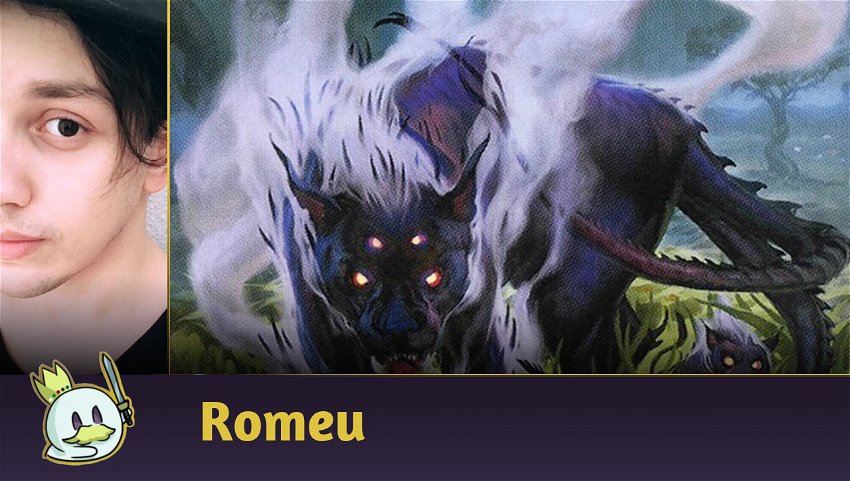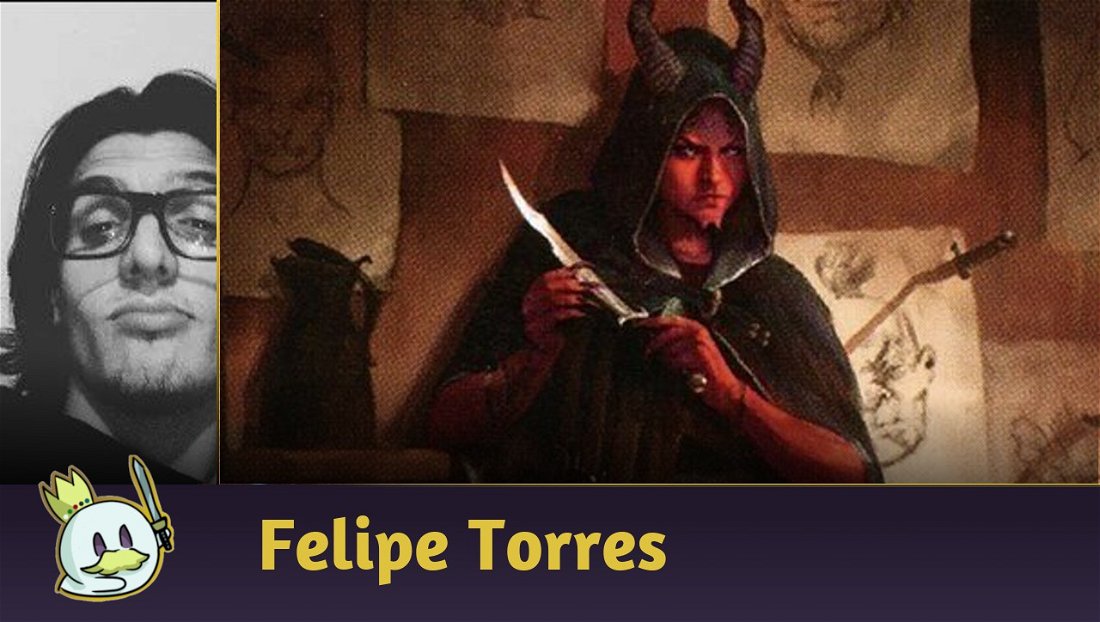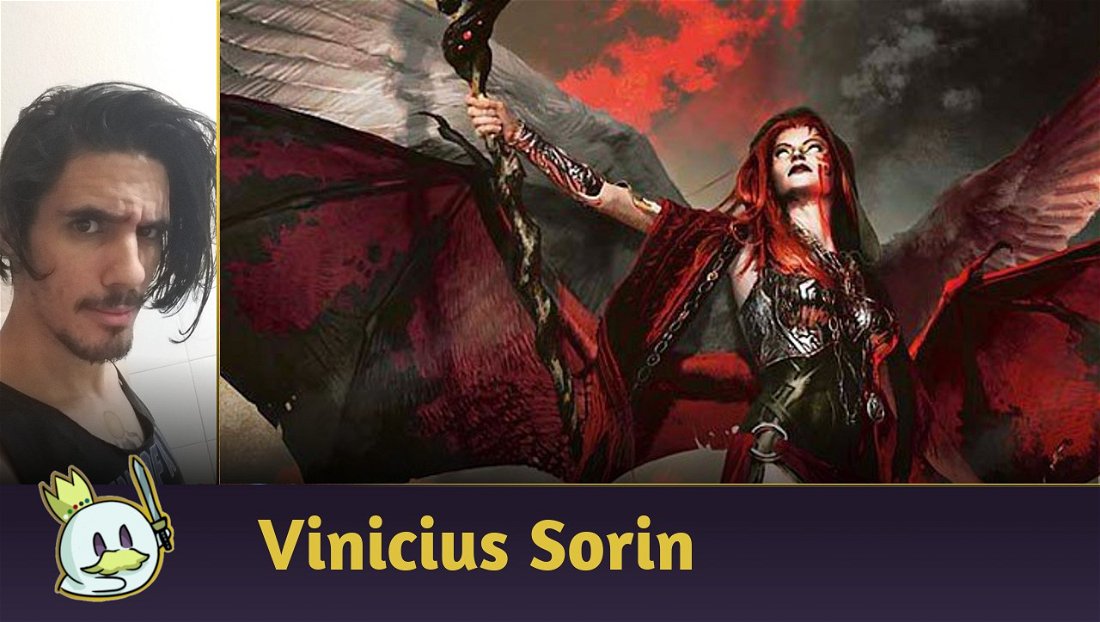After a brief two-week break, I'm back covering content primarily related to Pioneer (but you'll see me write about many other subjects and formats throughout the year, I assure you!), which has been my favorite competitive scene lately.
As a brief recap of what's happened in the last few weeks, we've seen that the format is in a relatively cyclical state among its main competitors, such as the absence of Burn due to the increase in the number of Vampires and Naya Winota, bringing Four-Color Ascendancy to the format's forefront and creating an environment where it becomes viable again to play Boros Heroic, a deck that has been declining for a few months, but which manages to catch up with a format where there are not so many removals and where players are more focused on trying to make their absurd thing before the opponent.
Ad
As a result, I'm guessing we'll have an addition of two deck categories in the coming weeks: aggressive-disruptive strategies such as Humans with Thalia, Guardian of Thraben and Elite Spellbinder or more Tempo-oriented versions of Spirits, and Black-Based Midrange or Control.
In particular, as long as the format is geared towards archetypes like Izzet Phoenix, Boros Heroic, Jeskai Ascendancy or Naya Winota, I think decks like Dimir Control have a good opportunity to fit into the Metagame as they include an essential mix of efficient removals and hand disruption, plus the obvious inclusion of Narset, Parter of Veils, which significantly delays any archetype whose goal is to abuse cantrips and other means of drawing cards.
However, as nothing very “exclusive” has emerged these weeks, I decided to bring you a Deck Tech with a different proposal: I will not be mentioning today an archetype or list that made results in a Challenge, but a creation of my own, built two hours before the beginning of a local event and that managed to obtain a good result, despite having been built practically based on improvisation and, although I am absolutely aware that “one result” is not enough to prove the efficiency of a deck, consider it as a fun account of my local Metagame, and where I intend to elaborate what led me to the choices on the list, trying to demonstrate how deckbuilding can be elaborated in theory and in practice.
A local Metagame's context
I play Pioneer weekly at a local store. Although we don't have many players each week, especially due to a pandemic that doesn't allow filling halls and demand that retailers and event organizers limit the number of subscribers and establish rules to keep the environment safe, I consider the scenario of my local store to be competitive : it is not uncommon to see players using the best decks of the format, it is not uncommon to see three or more players playing Izzet Phoenix, two piloting Naya Winota, others playing Jeskai Ascendancy, and it is also very common to see players changing decks to follow the Metagame, like the last week of 2021, where two went with Jund Citadel instead of their usual lists, and more than half of them are used to competitive events, and you would commonly see them playing in the old PTQs, planning trips in group to local MagicFests and who also regularly play in Leagues and other Magic Online and Magic Arena events.
Because of this, my deck of choice is always Izzet Phoenix, as I consider it the most efficient archetype in the format, and because it fits a strategy that I am already widely used to piloting in all competitive formats: Tempo decks.
However, with a week when most players were playing Izzet Phoenix, I expected players to try to take advantage of this to catch up with the archetype, with a significant increase in answers to the deck and possibly an increase in the number of Burn and Azorius Control.
I don't tend to tweak with my decks that often for weekly tournaments, and I had an idea that the most sensible option would probably be to switch to a Jeskai version with Sunset Revelry, Wear // Tear and Monastery Mentor, or keep the Izzet version and increase the number of Aether Gust and Mystical Dispute and/or Negate and accept that there are matchups that I just can't beat.
Ad
But honestly, I was bored with playing Phoenix and wanted to try something different that I had fun playing with, or even not play that week just because I was bored. It's not like I lose a lot by not going to play, nor like I gain a lot by participating: I currently play Magic because I like to enjoy the games.
But I would have to go to the store anyway: I was selling some cards and I would sell them to someone who would be there, the trip was inevitable, so at least I would enjoy my trip and play cards and enjoy my games and, if the idea was to just have fun, at least I should try something fun.
Which brings us, ironically, to Modern.
Honestly, I really like where Modern is currently. While the format is unrecognizable compared to the pre-Modern Horizons II era, it feels so “Legacy-lite” and so geared towards mana efficiency that the games are exciting to watch and play, and I miss having that touch with it on in-person events.
It is common knowledge that my favorite Magic deck and the one that has given me the most good results over the years has been Death's Shadow, and I miss playing Death's Shadow, but the fact that the lists already starts with a Ragavan, Nimble Pilferer playset (and there is no viable replacement for this card, which is precisely the main reason for its current price tag) simply take me away from the archetype and the tabletop format, where there are no Loan Programs, as in Magic Online.
Obviously, there's no Death's Shadow in Pioneer (and Scourge of the Skyclaves isn't nearly enough), and we also don't have super efficient creatures like Dragon's Rage Channeler, but I also have great admiration for the spell base of Modern's Tempo and Control decks, which commonly involves Thoughtseize, Expressive Iteration and low-cost removals/disruptions. So, why not try to take advantage of spells that have a power level worthy of Modern, coupled with cards that fit the Pioneer context?
Now, we all know that homebrew decks are statistically more unlikely to get good results because they don't have the refinement of a huge community and collective mind working to improve the list as the format adapts, and I wouldn't recommend anyone if your goal is to win (I always say that if you want to win, there are three options: Play with the best deck, or play with the one that beats the best deck, or play with the archetype that has the best “free-win” engine), but there's no reason to want to play so focused on winning at a local store event where you've paid a symbolic entry fee.
I don't think I would do the same in a bigger tournament like a Grand Prix or even a Challenge, as they require much more preparation and investment than a local tournament, but I chose to enjoy playing Magic over instead of compete, do my best and improve my game without having to always be worried about the best result. My relationship with the game is much healthier this way, and when/if major events return, it will be much better for me on a personal level if I'm there to improve my content and game experience and interact with the community than to pursue the dream of winning a huge tournament.
Ad
I know, it probably sounds silly and an obvious statement to many players, but for me, given how long I've seen my results as a path where there's only the best or the worst, this is huge progress in my maturation as an individual, player and content creator.
However, this is a subject for another article where I intend to raise some issues about the correlation between Magic and mental health, which should be out soon, I hope.
Today, we're here for a Deck Tech!
The Decklist
In essence, this deck is a Grixis Midrange with Thing in the Ice as the main wincondition, and it seeks to take advantage of the interaction of Lurrus of the Dream-Den with Bloodthirsty Adversary to generate a huge amount of late-game value.

About a month ago, I thought Thing in the Ice's interaction with Heartless Act was pretty much a two-card combo, only to realize, on rereading the cards, that the interaction didn't work like I thought, so if I wanted to use both cards because they're naturally good on their own, I'd also need more one mana spells to be able to transform Thing in the Ice quickly if necessary, or even with two activations of Bloodthirsty Adversary, casting Heartless Act to remove the counters and a second spell to transform it, and returning the vampire to your hand be replayed next turn.
This deck has some peculiar points, such as not being as Control as a traditional archetype like Azorius or Dimir, and also not being as proactive as a more common Midrange like Rakdos or Vampires, but it ends up sequencing its plays better, as its spells tend to have a lower cost, in addition to Expressive Iteration being naturally absurd as a Card Selection and Card Advantage engine.
Maindeck



This, of course, comes at a cost: The mana requirements of this list are too greedy.
You preferably want to have black mana on turn 1 for Thoughtseize, a blue mana on turn 2 for Thing in the Ice, and preferably blue and red mana on turn 3 without needing a third land drop to play Expressive Iteration, find black mana, and cast Fatal Push or Bloodchief's Thirst in the same turn.
Because of this, the fact that we don't have Triomes in the Grixis colors (which I hope Streets of New Capenna can change), and because I didn't have Clearwater Pathway in the binder, I opted for a classic Manabase from the Innistrad-Ravnica Standard, where three-color decks were very common: Shocklands + Checklands, and supplemented with a set of Spirebluff Canal to increase the chances of having UR on turn 3 without the third land drop.
The amount of each was based on the mana requirements of the first few turns, though I think I'd like a fourth Blood Crypt in place of a Checkland.
Ad
The other lands were also based on the color requirements of the first turns, as well as serving as winconditions on a controlled board, and Swamp was included due to the occasional Field of Ruin that some archetypes have.

Thing in the Ice is a great Control finisher since it was released, as it is a good blocker in the early game and a threat capable of giving a mighty Time Walk against the opponent, while attacking for 7 every turn at a clean board.
As this list has many spells, besides the obvious Heartless Act interaction, it's not too difficult to transform it, but the creature is also a terrible topdeck if you've already spent all of your resources.
Speaking of resources, Bloodthirsty Adversary is a powerful late-game wincondition that can also set early-game pressure when needed against non-interactive decks, but its true use lies in the mid to late game, when it will always be accompanied by one or two spells from your graveyard and with a bigger body, capable of turning the game around with the most diverse effects, in addition to helping substantially to transform Thing in the Ice.
Lurrus of the Dream-Den is another wincondition and powerful engine, a 3/2 body with Lifelink can take some work on an empty board, but its main use is as a constant way to resort to your threats in Late-Game, especially Bloodthirsty Adversary, and there's a plethora of interactions these two cards can do with each other over the course of the game.

One way we have to keep interactions flowing between Lurrus of the Dream-Den and Bloodthirsty Adversary is the ability to make them deplete the opponent's resources with the value offered by Kolaghan's Command.
Dragons of Tarkir's instant has always been highly valued in eternal formats, and is in a well-positioned situation in the format as it helps to recover from removals, destroys important artifacts such as Witch's Oven, Esika's Chariot and even Portable Hole, removes resources from the opponent and also deals with small creatures, and the fact that it can be recast by Bloodthirsty Adversary creates an amount of value similar to what we see in Modern with Snapcaster Mage.
Galvanic Iteration was supposed to be the third Kolaghan's Command but in his absence I chose to test a copy spell effect through versatility, which proves to be devastating when you copy Go Blank or Thoughtseize against Control decks, or Heartless Act after a sweeper.

I wanted to avoid playing Dreadbore or Bedevil because of their high color requirement, and Baleful Mastery seemed like a good answer for Planeswalkers, with the bonus of being able to exile an Arclight Phoenix or Kroxa, Titan of Death's Hunger.
Ad
I originally had a 2-2 Split of Fatal Push and Bloodchief's Thirst, but I really feared that Planeswalkers would be a problem because they can easily outweigh the value this deck generates with its spells if they stick around for a long time, and as there aren't many ways to activate Revolt, 3-1 felt like the right number.
And the main Instant-Speed interaction for creatures was Heartless Act, as the only relevant creatures this card doesn't destroy, such as Thing in the Ice or Tenth District Legionnaire, can be resolved with the other removals, and its interaction with your own Thing in the Ice becomes an occasional bonus that can turn a losing game against super-aggressive creature decks.
Finally, my sweeper of choice was Anger of the Gods, for not only resolving most creatures against archetypes where sweepers are really needed, but also because it can be used a turn early, an essential point to deal with decks like Burn, Humans, or Naya Winota before the opponent can cast Winota, Joiner of Forces.
The exile part also becomes critical when dealing with Arclight Phoenix or other recurring threats.

Expressive Iteration is one of the most powerful card selection effects in recent years, and a lot of the consistency this archetype has in finding the right land drops and spells comes from the power that Strixhaven's sorcery has in the first few turns, when ensure good spell sequencing, or the necessary land drops, while allowing you to filter the top of your deck.
Speaking of filtering the top Consider was chosen for the list as it is a cheap and efficient way to have a one mana Instant-Speed unconditional spell to interact with Thing in the Ice, serving as a complementary, but important, top-notch filtering feature, especially in early-game or later stages where you need a specific answer.
Finally, as I want to recast my spells with Bloodthirsty Adversary, I wanted to avoid using Delve spells like Dig Through Time and opted instead for Memory Deluge, which allows for a powerful card selection at Instant-Speed, which can be replayed from the graveyard with an even wider effect, granting a powerful Card Advantage resource

Thoughtseize is essential in a format where decks like Four-Color Ascendancy look for specific cards to close their combo and have no difficulty finding them, as well as being used to protect your Thing in The Ice which will be played on turn 2, or remove a threat from the opponent's hand.
Go Blank remains a powerful discard and graveyard hate effect that is very useful in non-creature-based decks, and even against more aggressive archetypes, using it to remove the last resources from the opponent's hand is applicable and very useful after a sweeper or 1-for-1 trades, where they will have few cards in their hand (but obviously, you shouldn't keep it in post-sideboard games against aggressive decks).
Ad
Sideboard
As can be seen, the Sideboard was built with an experimental purpose, with several one-ofs and trying to cover as many situations in the most diverse ways as possible, but with cards whose usefulness is not limited to just a few specific occasions, but can be used in several different games.

The only card with four copies on the Sideboard is Aether Gust, as it is incredibly well positioned in the current Metagame.
Among a multitude of creatures from Naya Winota, cards like Sylvan Awakening and Jeskai Ascendancy, threats like Arclight Phoenix and Crackling Drake, plus all the spells from Burn and Chonky Red, I see no reason to run less than four copies while these archetypes are still present in the Metagame.
The card may not be the most efficient answer to any of them, but it is definitely the most comprehensive and effective among the options that the format offers.

Izzet Phoenix needs to be respected, and I wanted a card that could handle both this archetype and other Midrange or spell-based decks looking to use their graveyard as a resource, like Four-Color Ascendancy or Boros Heroic.
Go Blank is also strangely useful against Burn, as it has a hard time recovering its resources and commonly prefers to opt for creatures over spells. It also has great use against Control, especially if recast through Bloodthirsty Adversary one or two turns later.

I'm not a big fan of Mystical Dispute on decks that goes too much into the late game, and with such a proactive stance, where I'll usually be using my mana on my own turn, I tried to reduce the number of counterspells needed for more discard effects.
However, we can't just count on the opponent's topdeck to be bad. Therefore, some counters are necessary to protect your threats or respond to the opponent's, and Negate is the best two mana answer Blue has to offer in this color combination to deal with the most diverse situations.
Test of Talents is a great way to remove certain cards from your opponent with a single spell, and I thought it was important to have a copy to occasionally resolve a Sylvan Awakening, Treasure Cruise or even a Go Blank permanently.

The extra discard package includes a selection of more situational one-ofs like discards, but forgoes the use of an important Sideboard piece: Duress.
The main reason Duress didn't make it is that I really wanted cards to do more than "just" discard because that function is already covered with Thoughtseize and I wanted to make sure the rest inclusions had other relevant effects.
Collective Brutality is lifegain, removal and discard all in one card and does a bit of every element you need, and can go against both Aggro and Combo decks.
Agonizing Remorse isn't the best option, and I could have chosen a more interesting option like a second copy of one of the other cards, but it's still very useful in permanently removing a threat from your opponent's hand or graveyard, being able to resolve Arclight Phoenix or Kroxa, Titan of Death's Hunger before the opponent has the opportunity to replay them.
Ad
Finally, I wanted an effect that could reduce the opponent's resources to scarcity, especially when facing a Control deck, and Thought Distortion does that job well, especially if I can keep Planeswalkers off the board.

Among the extra removals, one that was definitely not needed was Lava Coil, and I probably put it there because I respect Izzet Phoenix too much and wanted a clean answer to Winota, Joiner of Forces, Thing in the Ice and Crackling Drake on a single card.
Mizzium Mortars or Languish would be better in this slot, as they act as sweepers.
Abrade is a good Instant-Speed answer that handles a variety of creatures, while also resolving Witch's Oven and Esika's Chariot, making it versatile for many games.
Fry was a card I added because I wanted an efficient answer to Winota, Joiner of Forces and Teferi, Hero of Dominaria and that I could also use to deal with Narset, Parter of Veils or other blue threats like Thing in the Ice or Spirits in general.
Performance Analysis
In addition to the event (where I finished 3-0 and had a split in the last round), I rented this list on Magic Online and tested it in two leagues, with results of 4-1 and 3-2, respectively.
I think it's not enough for sample size, but I don't really have much time to play Leagues lately.
Grixis Lurrus is very powerful against Combo decks and other archetypes with a greater focus on making their own strategy than interacting with the opponent, it is also effective in dealing with archetypes that try to attack you quickly, while also being able to strongly turn the tide and win in a few turns using Thing in the Ice + Removals.
It can also trade 1-for-1 and gain card advantage with some ease against other Midranges, but it doesn't do very well when the other side of the table manages to sequence a more efficient mix of disruption + creatures, like Vampires.
Another point where the list does not play an exemplary role in the current configuration is facing more dedicated Control decks, such as Azorius or some versions of Dimir, since their late-game is superior to yours, and they can accumulate more card advantage than you, which demands the use of more efficient threats or more accurate answers for these games.
Last, but not least, its manabase can stumble a bit if you keep lands that doesn't meet the right color requirements.
Possible Additions
There are many angles from which this list can be better explored, but I think points that need to be better addressed are the number of threats and ways to keep up with the card advantage of other Controls, along with an improved manabase, but to accomplish this feat without compromising consistency or the need for certain cards on the list is a huge challenge.

Tibalt, Cosmic Impostor is a great late-game bomb, able to win the game alone if not answered properly, but no game is really won by the Planeswalker because it is cast fairly and for seven mana, but when you can play him earlier via a Bring to Light, like Sultai Lurrus used to do months ago.
Ad
However, the only viable option to cast Tibalt for a low cost besides Bring to Light is Release to the Wind, a mediocre card on its own and doesn't interact well with the rest of the deck (although it interacts decently with Adventures creatures, like Bonecrusher Giant, Brazen Borrower and Murderous Rider, but that would be another focus).

Jace, Vryn's Prodigy was once a staple precisely because it was one of the best ways to recast Thoughtseize and Kolaghan's Command, while also being, in its own right, a late-game threat and a card selection engine.
I believe he fits very well in serving to establish card advantage and create additional threats, and could probably be used even in place of Consider, but his frail body and inability to establish short-term pressure make me uncomfortable, making me a bit skeptical about his usefulness.

Kroxa, Titan of Death's Hunger is a threat capable of winning games on its own, but that seems to me to interact negatively with the rest of what I try to accomplish on the list, in particular with Bloodthirsty Adversary.
It is obvious that Kroxa is probably much better than Bloodthirsty Adversary, and is a plausible option as a threat alongside Thing in the Ice rather than the vampir, but I don't think he really works as a complementary threat to the ones already used in the deck, and I feel that archetypes like Rakdos Arcanist are better to use it.

There are countless other options for additional threats, and the point is figuring out which ones are really useful and which aren't for the archetype's strategy.
For example, Pack Rat is one of my favorite creatures, and it fits in well as an additional threat because it doesn't need the graveyard to be good, and it doesn't need additional spells being cast, but it does require a steady stream of Card Advantage.
Concealing Curtains is a good early game blocker and late-game threat, with an ability similar to other creatures that have seen a lot of play over the years, such as Vendilion Clique or Thought-Knot Seer, but it's easily answered. Its mana investment can also be easily wasted by a removal in response to its ability.
Young Pyromancer interacts negatively with Thing in the Ice, but is a great companion threat to build pressure and create good blockers.
Spectral Adversary is an Instant-Speed threat that can remove attacking or blocking creatures out of the way, or protect your threats, but doesn't offer a decent way to gain card advantage.

Ad
In the card advantage sector, we also have other decent options, like Painful Truths and Behold the Multiverse as spells that offer a decent amount of Card Advantage, or even Dig Through Time, which doesn't lose much utility if cast for four or five mana on late-game.
As for creatures, Abbot of Keral Keep offers a way to get some card advantage in a proactive deck and interacts well with the deck's proposal, whereas Robber of the Rich offers the opponent's cards as resources, but his ability is conditional, and he doesn't attack very well, and Augur of Bolas is a good early-game blocker that can be useful for finding more answers at any stage of the game.

Obviously, another point that can be better worked according to the needs of each Metagame is the Sideboard, and there is no lack of options in the Grixis colors for almost any occasion.
Conclusion
That's all for today.
I hope my list caught your attention, and I intend to play Grixis Lurrus a few more times this week and next to see how far I can get in the list and results, especially in a scenario where I'm not really compelled to play Izzet Phoenix for some time.
Speaking of Izzet Phoenix, unless we have an announcement of banned and restricted this week, you can expect a full Deck Guide during the spoiler season of Kamigawa: Neon Dynasty, as I consider it unlikely that bans will occur during the preview weeks.
Until then, some interesting decks have emerged from this weekend's events, and I plan to talk a bit about them in the coming days as well.
As for Pauper: I don't intend to talk about the format until the first changes proposed by the Pauper Format Panel take place, as I believe that waiting and watching is the best course of action for the community currently (as we are now aware that there are people with experience and understanding of the format observing it and considering which changes need to be made).
Thanks for reading!








— Comments0
Be the first to comment